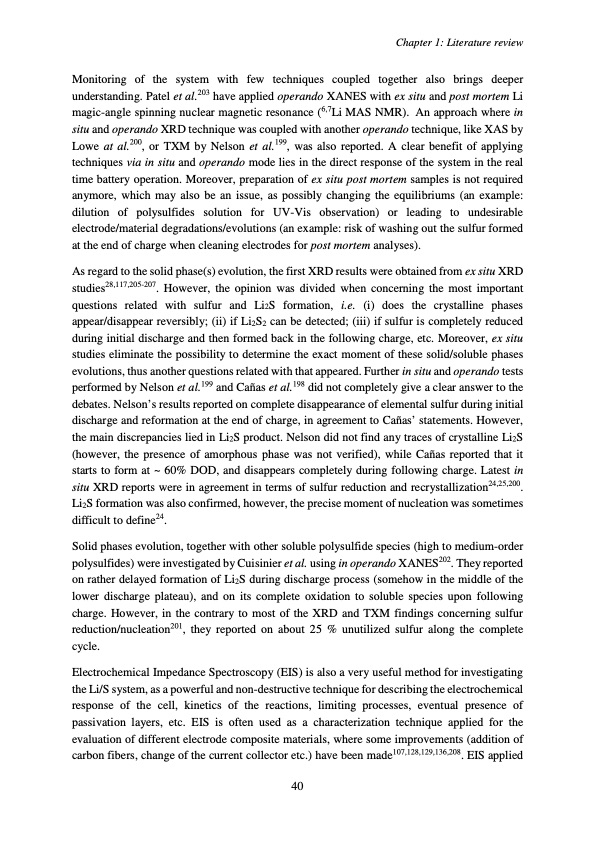
PDF Publication Title:
Text from PDF Page: 044
Monitoring of the system with few techniques coupled together also brings deeper understanding. Patel et al.203 have applied operando XANES with ex situ and post mortem Li magic-angle spinning nuclear magnetic resonance (6,7Li MAS NMR). An approach where in situ and operando XRD technique was coupled with another operando technique, like XAS by Lowe at al.200, or TXM by Nelson et al.199, was also reported. A clear benefit of applying techniques via in situ and operando mode lies in the direct response of the system in the real time battery operation. Moreover, preparation of ex situ post mortem samples is not required anymore, which may also be an issue, as possibly changing the equilibriums (an example: dilution of polysulfides solution for UV-Vis observation) or leading to undesirable electrode/material degradations/evolutions (an example: risk of washing out the sulfur formed at the end of charge when cleaning electrodes for post mortem analyses). As regard to the solid phase(s) evolution, the first XRD results were obtained from ex situ XRD studies28,117,205-207. However, the opinion was divided when concerning the most important questions related with sulfur and Li2S formation, i.e. (i) does the crystalline phases appear/disappear reversibly; (ii) if Li2S2 can be detected; (iii) if sulfur is completely reduced during initial discharge and then formed back in the following charge, etc. Moreover, ex situ studies eliminate the possibility to determine the exact moment of these solid/soluble phases evolutions, thus another questions related with that appeared. Further in situ and operando tests performed by Nelson et al.199 and Cañas et al.198 did not completely give a clear answer to the debates. Nelson’s results reported on complete disappearance of elemental sulfur during initial discharge and reformation at the end of charge, in agreement to Cañas’ statements. However, the main discrepancies lied in Li2S product. Nelson did not find any traces of crystalline Li2S (however, the presence of amorphous phase was not verified), while Cañas reported that it starts to form at ~ 60% DOD, and disappears completely during following charge. Latest in situ XRD reports were in agreement in terms of sulfur reduction and recrystallization24,25,200. Li2S formation was also confirmed, however, the precise moment of nucleation was sometimes difficult to define24. Solid phases evolution, together with other soluble polysulfide species (high to medium-order polysulfides) were investigated by Cuisinier et al. using in operando XANES202. They reported on rather delayed formation of Li2S during discharge process (somehow in the middle of the lower discharge plateau), and on its complete oxidation to soluble species upon following charge. However, in the contrary to most of the XRD and TXM findings concerning sulfur reduction/nucleation201, they reported on about 25 % unutilized sulfur along the complete cycle. Electrochemical Impedance Spectroscopy (EIS) is also a very useful method for investigating the Li/S system, as a powerful and non-destructive technique for describing the electrochemical response of the cell, kinetics of the reactions, limiting processes, eventual presence of passivation layers, etc. EIS is often used as a characterization technique applied for the evaluation of different electrode composite materials, where some improvements (addition of carbon fibers, change of the current collector etc.) have been made107,128,129,136,208. EIS applied 40 Chapter 1: Literature reviewPDF Image | Accumulateur Lithium Soufre

PDF Search Title:
Accumulateur Lithium SoufreOriginal File Name Searched:
WALUS_2015_archivage.pdfDIY PDF Search: Google It | Yahoo | Bing
Sulfur Deposition on Carbon Nanofibers using Supercritical CO2 Sulfur Deposition on Carbon Nanofibers using Supercritical CO2. Gamma sulfur also known as mother of pearl sulfur and nacreous sulfur... More Info
CO2 Organic Rankine Cycle Experimenter Platform The supercritical CO2 phase change system is both a heat pump and organic rankine cycle which can be used for those purposes and as a supercritical extractor for advanced subcritical and supercritical extraction technology. Uses include producing nanoparticles, precious metal CO2 extraction, lithium battery recycling, and other applications... More Info
| CONTACT TEL: 608-238-6001 Email: greg@infinityturbine.com | RSS | AMP |